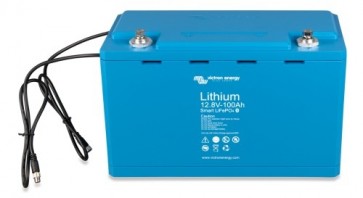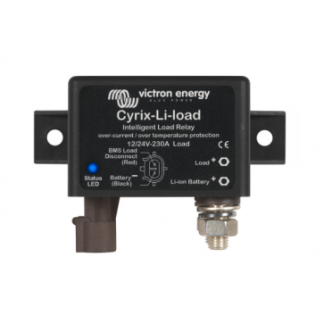Description
Victron LiFePO battery 12.8V/100Ah – Smart
Why lithium-iron-phosphate?
Lithium-iron-phosphate (LiFePO4 or LFP) is the safest of the mainstream li-ion battery types. The nominal voltage of a LFP cell is 3,2V (lead-acid batteries: 2V/cell). A 12,8V LFP battery therefore consists of 4 cells connected in series; and a 25,6V battery consists of 8 cells connected in series.
Service life
LFP battery does not need to be fully charged. Service life even slightly improves in case of partial charge instead of a full charge. This is a major advantage of LFP compared to lead-acid. Other advantages are the wide operating temperature range, excellent cycling performance, low internal resistance and high efficiency.
Efficiency
In several applications (especially off-grid solar and/or wind), energy efficiency can be of crucial importance.
The round trip energy efficiency of a LFP battery is 92%.
The charge process of lead-acid batteries becomes particularly inefficient when the 80% state of charge has been reached, resulting in efficiencies of 50% or even less in solar systems where several days of reserve energy is required (battery operating in 70% to 100% charged state). In contrast, a LFP battery will still achieve 90% efficiency under shallow discharge conditions.
Cell balancingand and monitoring
LFP batteries have integrated cell balancingand cell monitoring. Up to 5 batteries can be paralleled and up to four 12V batteries or two 24V batteries can be series connected, so that a 48V battery bank of up to 1500Ah can be assembled. The cell balancing/monitoring cables can be daisy-chained and must be connected to a Battery Management System(BMS).
Bluetooth app available to monitor cell voltage and temperature.
Battery Management System (BMS)
The BMS will:
1.Generate a pre-alarm whenever the voltage of a battery cell decreases to less than 3,1V (adjustable 2,85-3,15V).
2.Disconnect or shut down the load whenever the voltage of a battery cell decreasesto less than 2,8V (adjustable 2,6V-2,8V).
3.Stop the charging process whenever the voltage of a battery cell increases to more than 4,2V.
4.Shut down the system whenever the temperature of a cell exceeds 50°C.
Requires one of these BMS-es:
VE.Bus BMS – recommended for systems with our inverter/chargers.
Victron miniBMS – recommend for use in small systems.
Battery Management System BMS 12/200 – recommend for use in Automotive and Marine systems having DC-loads and Alternators.
Smart BMS CL 12/100 – recommended for use in Automotive and Marine systems having DC-loads and Alternators.
Dimensions (hxwxd) mm – 197 x 321 x 152
Weight – 15 kg
Nominal energy @ 25°C* – 1280 Wh



